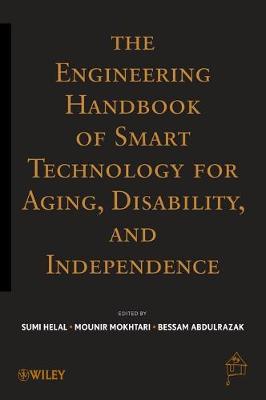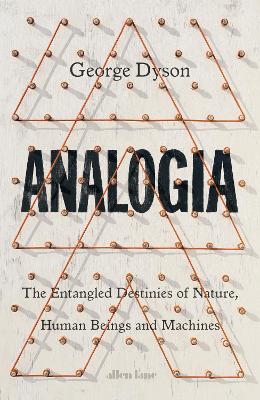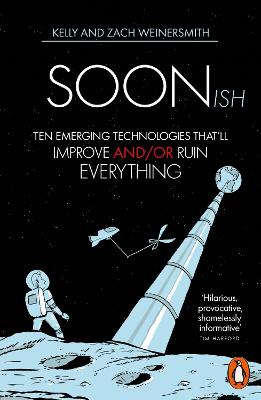Engineering Handbook of Smart Technology for Aging, Disability, and Independence
 -15%
portes grátis
-15%
portes grátis
Engineering Handbook of Smart Technology for Aging, Disability, and Independence
Abdulrazak, Bessam; Mokhtari, Mounir; Helal, Abdelsalam
John Wiley & Sons Inc
10/2008
968
Dura
Inglês
9780471711551
15 a 20 dias
1792
Descrição não disponível.
Foreword. Preface.
Author Biography.
Contributors.
Introduction to the book (Sumi Helal, Mounir Mokhtari, Bessam Abdulrazak and Mark Schmalz).
PART I: DEFINITIONS, CLASSIFICATIONS, AND POLICIES.
Chapter 1: Technology for Successful Aging and Disabilities (Amol Karmarkar, Eliana Chavez and Rory A. Cooper).
Chapter 2: International Policy Context of Technologies for Disabilities: An Analytical Framework (Rene Jahiel).
Chapter 3: Technology for Individuals with Disabilities: Government and Market Policies (Katherine D. Seelman).
Chapter 4: Assistive Technology and the International Classification of Functioning, Disability and Health (Jerome Bickenbach).
Chapter 5: Technology for Integration of Students with Disabilities in Higher Education (Marci Kinas Jerome, Kristine Neuber, Brianna Stegall, Anna Emenova and Michael Behrmann).
Chapter 6: ISO 9999 Assistive Products for Persons with Disability - Classification and Terminology (Ir. Theo Bougie).
PART II: USERS, NEEDS, AND ASSISTIVE TECHNOLOGY.
Chapter 7: Low Tech Assistive Technology (Kathleen Laurin and Jill Sherman).
Chapter 8: People with Visual Disabilities (John Gill and Linda Newson).
Chapter 9: Assistive Devices for People with Visual Impairments (John Gill).
Chapter 10: Assistive Devices for People with Hearing Loss (Matthew H. Bakke).
Chapter 11: People with Cognitive Disabilities (Mary Kay Rizzolo and David Braddock).
Chapter 12: Assistive Devices for People with Cognitive Impairments (Helene Pigot, Jeremy Bauchet and Sylvain Giroux).
PART III: HUMAN-MACHINE INTERACTION & ALTERNATIVE COMMUNICATION.
Chapter 13: Computer Access in the Workplace (Karen Milchus and Carrie Bruce).
Chapter 14: Platforms & Operating Systems Accessibility (Barry Feigenbaum and Kip Harris).
Chapter 15: Voice Interactive Systems (Rudzionis Algimantas, Kastytis Ratkevicius and Vytautas Rudzionis).
Chapter 16: The Communication Assistant (Alternative Communication) (Leanne West).
Chapter 17: Wearable Systems Design Issues for Aging or Disabled Users (Maribeth Gandy, Tracy Westeyn, Helene Brashear and Thad Starner).
Chapter 18: Tactile Displays (Stephen A. Brewster, Steven A. Wall, Lorna M. Brown and Eve E. Hoggan).
PART IV: ASSISTIVE ROBOTICS.
Chapter 19: Assistive Robotics for Independent Living (Bessam Abdulrazak and Mounir Mokhtari).
Chapter 20: Mobile Platform-Based Assistive Robot Systems (Zeungnam Bien, Dae-Jin Kim, Kwang-Hyun Park, Jin-Woo Jung, Jin-Oh Kim, Myung Jin Chung and Pyung-Hun Chang).
Chapter 21: Robot Therapy at Elderly Institution - Effects of Long-Term Interaction with Seal Robots (Takanori Shibata and Kazuyoshi Wada).
Chapter 22: Prostheses - Human Limbs and Their Artificial Replacements (Richard F. ff. Weir).
PART V: USER MOBILITY.
Chapter 23: Wheelchairs within the Context of Smart House Design (Dimitar Stefanov).
Chapter 24: People with Special Needs and Traffic Safety (Nahid Shahmehri, Ioan CHISALITA and Iohan Aberg).
Chapter 25: Blind Navigation and the Role of Technology (Nicholas Giudice and Gordon Legge).
Chapter 26: Walker Systems (Andrew Rentschler).
Chapter 27: Accessible Public Transportation Services in America (Katharine M. Hunter-Zaworski).
Chapter 28: Transportation Services in Europe (Isabelle Dussutour).
Chapter 29: Transportation Services in Asia (Joseph Kwan and Eric W.C. Tam).
PART VI: TECHNOLOGIES FOR SMART ENVIRONMENTS.
Chapter 30: Modeling the Well-Being of Older People (Andrew Sixsmith).
Chapter 31: Context Awareness (Jadwiga Indulska and Karen Henricksen).
Chapter 32: Middleware for Smart Spaces (Daqing Zhan,g Tao Gu and Manli Zhu).
Chapter 33: Privacy, Security and Safety Technologies (Abdallah M'hamed).
Chapter 34: Automated Medication Management Devices (RJ Davies, Christopher Nugent, DD Finlay, D Craig and ND Black).
Chapter 35: Virtual Companions (Nahid Shahmehri, Johan berg and Dennis Maciuszek).
Chapter 36: Textile Sensing & e-Textile (Smart Textile) (Rita Paradiso, Nicola Taccini and Giannicola Loriga).
Part VII: Smart Environments and Cyberinfrastructures.
Chapter 37: The Gator Tech Smart House: A Programmable Pervasive Space (Sumi Helal).
Chapter 38: Health Application & Telecare (Mathijs Soede, Frank Vlaskamp and Charles Willems).
Chapter 39: Immersive Tele-Care for Assisting People with Special Needs (Sumi Helal and Bessam Abdulrazak).
Chapter 40: Smart Systems in Personal Transportation (Aaron Steinfeld).
Chapter 41: Tools for Studying Novel Proactive HealthCare Applications for Places of Living (Stephen Intille and Kent Larson).
Chapter 42: Algorithms for Smart Spaces (Diane J. Cook, G. Michael Youngblood and Gaurav Jain).
PART VIII: EMERGING STANDARDS, GUIDELINES & DESIGN METHODS.
Chapter 43: User-Sensitive Design for Older and Disabled People (Alan Newell).
Chapter 44: Universal Design/Design for All: Practice and Method (Edward H Steinfeld).
Chapter 45: Design for Well-Being (Andreas Larsson and Tobias Larsson).
Chapter 46: Technology Evaluation within Health and Social Care (Suzanne Martin, George Kernohan, Bernadette Mc Creight and Christopher Nugent).
Chapter 47: Usability in Designing Assistive Technologies (Jean-Claude SPERANDIO and Marion Wolff).
Chapter 48: Smart Home and Health Telematics: Standards for and with Users (Milan Erbes).
Chapter 49: ICT Standardization for Elderly and People with Disabilities in Japan (Hajime Yamada).
Index.
Author Biography.
Contributors.
Introduction to the book (Sumi Helal, Mounir Mokhtari, Bessam Abdulrazak and Mark Schmalz).
PART I: DEFINITIONS, CLASSIFICATIONS, AND POLICIES.
Chapter 1: Technology for Successful Aging and Disabilities (Amol Karmarkar, Eliana Chavez and Rory A. Cooper).
Chapter 2: International Policy Context of Technologies for Disabilities: An Analytical Framework (Rene Jahiel).
Chapter 3: Technology for Individuals with Disabilities: Government and Market Policies (Katherine D. Seelman).
Chapter 4: Assistive Technology and the International Classification of Functioning, Disability and Health (Jerome Bickenbach).
Chapter 5: Technology for Integration of Students with Disabilities in Higher Education (Marci Kinas Jerome, Kristine Neuber, Brianna Stegall, Anna Emenova and Michael Behrmann).
Chapter 6: ISO 9999 Assistive Products for Persons with Disability - Classification and Terminology (Ir. Theo Bougie).
PART II: USERS, NEEDS, AND ASSISTIVE TECHNOLOGY.
Chapter 7: Low Tech Assistive Technology (Kathleen Laurin and Jill Sherman).
Chapter 8: People with Visual Disabilities (John Gill and Linda Newson).
Chapter 9: Assistive Devices for People with Visual Impairments (John Gill).
Chapter 10: Assistive Devices for People with Hearing Loss (Matthew H. Bakke).
Chapter 11: People with Cognitive Disabilities (Mary Kay Rizzolo and David Braddock).
Chapter 12: Assistive Devices for People with Cognitive Impairments (Helene Pigot, Jeremy Bauchet and Sylvain Giroux).
PART III: HUMAN-MACHINE INTERACTION & ALTERNATIVE COMMUNICATION.
Chapter 13: Computer Access in the Workplace (Karen Milchus and Carrie Bruce).
Chapter 14: Platforms & Operating Systems Accessibility (Barry Feigenbaum and Kip Harris).
Chapter 15: Voice Interactive Systems (Rudzionis Algimantas, Kastytis Ratkevicius and Vytautas Rudzionis).
Chapter 16: The Communication Assistant (Alternative Communication) (Leanne West).
Chapter 17: Wearable Systems Design Issues for Aging or Disabled Users (Maribeth Gandy, Tracy Westeyn, Helene Brashear and Thad Starner).
Chapter 18: Tactile Displays (Stephen A. Brewster, Steven A. Wall, Lorna M. Brown and Eve E. Hoggan).
PART IV: ASSISTIVE ROBOTICS.
Chapter 19: Assistive Robotics for Independent Living (Bessam Abdulrazak and Mounir Mokhtari).
Chapter 20: Mobile Platform-Based Assistive Robot Systems (Zeungnam Bien, Dae-Jin Kim, Kwang-Hyun Park, Jin-Woo Jung, Jin-Oh Kim, Myung Jin Chung and Pyung-Hun Chang).
Chapter 21: Robot Therapy at Elderly Institution - Effects of Long-Term Interaction with Seal Robots (Takanori Shibata and Kazuyoshi Wada).
Chapter 22: Prostheses - Human Limbs and Their Artificial Replacements (Richard F. ff. Weir).
PART V: USER MOBILITY.
Chapter 23: Wheelchairs within the Context of Smart House Design (Dimitar Stefanov).
Chapter 24: People with Special Needs and Traffic Safety (Nahid Shahmehri, Ioan CHISALITA and Iohan Aberg).
Chapter 25: Blind Navigation and the Role of Technology (Nicholas Giudice and Gordon Legge).
Chapter 26: Walker Systems (Andrew Rentschler).
Chapter 27: Accessible Public Transportation Services in America (Katharine M. Hunter-Zaworski).
Chapter 28: Transportation Services in Europe (Isabelle Dussutour).
Chapter 29: Transportation Services in Asia (Joseph Kwan and Eric W.C. Tam).
PART VI: TECHNOLOGIES FOR SMART ENVIRONMENTS.
Chapter 30: Modeling the Well-Being of Older People (Andrew Sixsmith).
Chapter 31: Context Awareness (Jadwiga Indulska and Karen Henricksen).
Chapter 32: Middleware for Smart Spaces (Daqing Zhan,g Tao Gu and Manli Zhu).
Chapter 33: Privacy, Security and Safety Technologies (Abdallah M'hamed).
Chapter 34: Automated Medication Management Devices (RJ Davies, Christopher Nugent, DD Finlay, D Craig and ND Black).
Chapter 35: Virtual Companions (Nahid Shahmehri, Johan berg and Dennis Maciuszek).
Chapter 36: Textile Sensing & e-Textile (Smart Textile) (Rita Paradiso, Nicola Taccini and Giannicola Loriga).
Part VII: Smart Environments and Cyberinfrastructures.
Chapter 37: The Gator Tech Smart House: A Programmable Pervasive Space (Sumi Helal).
Chapter 38: Health Application & Telecare (Mathijs Soede, Frank Vlaskamp and Charles Willems).
Chapter 39: Immersive Tele-Care for Assisting People with Special Needs (Sumi Helal and Bessam Abdulrazak).
Chapter 40: Smart Systems in Personal Transportation (Aaron Steinfeld).
Chapter 41: Tools for Studying Novel Proactive HealthCare Applications for Places of Living (Stephen Intille and Kent Larson).
Chapter 42: Algorithms for Smart Spaces (Diane J. Cook, G. Michael Youngblood and Gaurav Jain).
PART VIII: EMERGING STANDARDS, GUIDELINES & DESIGN METHODS.
Chapter 43: User-Sensitive Design for Older and Disabled People (Alan Newell).
Chapter 44: Universal Design/Design for All: Practice and Method (Edward H Steinfeld).
Chapter 45: Design for Well-Being (Andreas Larsson and Tobias Larsson).
Chapter 46: Technology Evaluation within Health and Social Care (Suzanne Martin, George Kernohan, Bernadette Mc Creight and Christopher Nugent).
Chapter 47: Usability in Designing Assistive Technologies (Jean-Claude SPERANDIO and Marion Wolff).
Chapter 48: Smart Home and Health Telematics: Standards for and with Users (Milan Erbes).
Chapter 49: ICT Standardization for Elderly and People with Disabilities in Japan (Hajime Yamada).
Index.
Este título pertence ao(s) assunto(s) indicados(s). Para ver outros títulos clique no assunto desejado.
disabilities, assistive devices, human machine interaction, virtual reality, robotics, car adaptations, medication reminder systems, meal preparation systems, guiding systems, games for the blind, music systems for the deaf, accessible devices, health engineering, assisted living, eldercare, elderly, rehabilitation science, clinical engineering, motor disabilities, visual and hearing impairments; human machine interaction
Foreword. Preface.
Author Biography.
Contributors.
Introduction to the book (Sumi Helal, Mounir Mokhtari, Bessam Abdulrazak and Mark Schmalz).
PART I: DEFINITIONS, CLASSIFICATIONS, AND POLICIES.
Chapter 1: Technology for Successful Aging and Disabilities (Amol Karmarkar, Eliana Chavez and Rory A. Cooper).
Chapter 2: International Policy Context of Technologies for Disabilities: An Analytical Framework (Rene Jahiel).
Chapter 3: Technology for Individuals with Disabilities: Government and Market Policies (Katherine D. Seelman).
Chapter 4: Assistive Technology and the International Classification of Functioning, Disability and Health (Jerome Bickenbach).
Chapter 5: Technology for Integration of Students with Disabilities in Higher Education (Marci Kinas Jerome, Kristine Neuber, Brianna Stegall, Anna Emenova and Michael Behrmann).
Chapter 6: ISO 9999 Assistive Products for Persons with Disability - Classification and Terminology (Ir. Theo Bougie).
PART II: USERS, NEEDS, AND ASSISTIVE TECHNOLOGY.
Chapter 7: Low Tech Assistive Technology (Kathleen Laurin and Jill Sherman).
Chapter 8: People with Visual Disabilities (John Gill and Linda Newson).
Chapter 9: Assistive Devices for People with Visual Impairments (John Gill).
Chapter 10: Assistive Devices for People with Hearing Loss (Matthew H. Bakke).
Chapter 11: People with Cognitive Disabilities (Mary Kay Rizzolo and David Braddock).
Chapter 12: Assistive Devices for People with Cognitive Impairments (Helene Pigot, Jeremy Bauchet and Sylvain Giroux).
PART III: HUMAN-MACHINE INTERACTION & ALTERNATIVE COMMUNICATION.
Chapter 13: Computer Access in the Workplace (Karen Milchus and Carrie Bruce).
Chapter 14: Platforms & Operating Systems Accessibility (Barry Feigenbaum and Kip Harris).
Chapter 15: Voice Interactive Systems (Rudzionis Algimantas, Kastytis Ratkevicius and Vytautas Rudzionis).
Chapter 16: The Communication Assistant (Alternative Communication) (Leanne West).
Chapter 17: Wearable Systems Design Issues for Aging or Disabled Users (Maribeth Gandy, Tracy Westeyn, Helene Brashear and Thad Starner).
Chapter 18: Tactile Displays (Stephen A. Brewster, Steven A. Wall, Lorna M. Brown and Eve E. Hoggan).
PART IV: ASSISTIVE ROBOTICS.
Chapter 19: Assistive Robotics for Independent Living (Bessam Abdulrazak and Mounir Mokhtari).
Chapter 20: Mobile Platform-Based Assistive Robot Systems (Zeungnam Bien, Dae-Jin Kim, Kwang-Hyun Park, Jin-Woo Jung, Jin-Oh Kim, Myung Jin Chung and Pyung-Hun Chang).
Chapter 21: Robot Therapy at Elderly Institution - Effects of Long-Term Interaction with Seal Robots (Takanori Shibata and Kazuyoshi Wada).
Chapter 22: Prostheses - Human Limbs and Their Artificial Replacements (Richard F. ff. Weir).
PART V: USER MOBILITY.
Chapter 23: Wheelchairs within the Context of Smart House Design (Dimitar Stefanov).
Chapter 24: People with Special Needs and Traffic Safety (Nahid Shahmehri, Ioan CHISALITA and Iohan Aberg).
Chapter 25: Blind Navigation and the Role of Technology (Nicholas Giudice and Gordon Legge).
Chapter 26: Walker Systems (Andrew Rentschler).
Chapter 27: Accessible Public Transportation Services in America (Katharine M. Hunter-Zaworski).
Chapter 28: Transportation Services in Europe (Isabelle Dussutour).
Chapter 29: Transportation Services in Asia (Joseph Kwan and Eric W.C. Tam).
PART VI: TECHNOLOGIES FOR SMART ENVIRONMENTS.
Chapter 30: Modeling the Well-Being of Older People (Andrew Sixsmith).
Chapter 31: Context Awareness (Jadwiga Indulska and Karen Henricksen).
Chapter 32: Middleware for Smart Spaces (Daqing Zhan,g Tao Gu and Manli Zhu).
Chapter 33: Privacy, Security and Safety Technologies (Abdallah M'hamed).
Chapter 34: Automated Medication Management Devices (RJ Davies, Christopher Nugent, DD Finlay, D Craig and ND Black).
Chapter 35: Virtual Companions (Nahid Shahmehri, Johan berg and Dennis Maciuszek).
Chapter 36: Textile Sensing & e-Textile (Smart Textile) (Rita Paradiso, Nicola Taccini and Giannicola Loriga).
Part VII: Smart Environments and Cyberinfrastructures.
Chapter 37: The Gator Tech Smart House: A Programmable Pervasive Space (Sumi Helal).
Chapter 38: Health Application & Telecare (Mathijs Soede, Frank Vlaskamp and Charles Willems).
Chapter 39: Immersive Tele-Care for Assisting People with Special Needs (Sumi Helal and Bessam Abdulrazak).
Chapter 40: Smart Systems in Personal Transportation (Aaron Steinfeld).
Chapter 41: Tools for Studying Novel Proactive HealthCare Applications for Places of Living (Stephen Intille and Kent Larson).
Chapter 42: Algorithms for Smart Spaces (Diane J. Cook, G. Michael Youngblood and Gaurav Jain).
PART VIII: EMERGING STANDARDS, GUIDELINES & DESIGN METHODS.
Chapter 43: User-Sensitive Design for Older and Disabled People (Alan Newell).
Chapter 44: Universal Design/Design for All: Practice and Method (Edward H Steinfeld).
Chapter 45: Design for Well-Being (Andreas Larsson and Tobias Larsson).
Chapter 46: Technology Evaluation within Health and Social Care (Suzanne Martin, George Kernohan, Bernadette Mc Creight and Christopher Nugent).
Chapter 47: Usability in Designing Assistive Technologies (Jean-Claude SPERANDIO and Marion Wolff).
Chapter 48: Smart Home and Health Telematics: Standards for and with Users (Milan Erbes).
Chapter 49: ICT Standardization for Elderly and People with Disabilities in Japan (Hajime Yamada).
Index.
Author Biography.
Contributors.
Introduction to the book (Sumi Helal, Mounir Mokhtari, Bessam Abdulrazak and Mark Schmalz).
PART I: DEFINITIONS, CLASSIFICATIONS, AND POLICIES.
Chapter 1: Technology for Successful Aging and Disabilities (Amol Karmarkar, Eliana Chavez and Rory A. Cooper).
Chapter 2: International Policy Context of Technologies for Disabilities: An Analytical Framework (Rene Jahiel).
Chapter 3: Technology for Individuals with Disabilities: Government and Market Policies (Katherine D. Seelman).
Chapter 4: Assistive Technology and the International Classification of Functioning, Disability and Health (Jerome Bickenbach).
Chapter 5: Technology for Integration of Students with Disabilities in Higher Education (Marci Kinas Jerome, Kristine Neuber, Brianna Stegall, Anna Emenova and Michael Behrmann).
Chapter 6: ISO 9999 Assistive Products for Persons with Disability - Classification and Terminology (Ir. Theo Bougie).
PART II: USERS, NEEDS, AND ASSISTIVE TECHNOLOGY.
Chapter 7: Low Tech Assistive Technology (Kathleen Laurin and Jill Sherman).
Chapter 8: People with Visual Disabilities (John Gill and Linda Newson).
Chapter 9: Assistive Devices for People with Visual Impairments (John Gill).
Chapter 10: Assistive Devices for People with Hearing Loss (Matthew H. Bakke).
Chapter 11: People with Cognitive Disabilities (Mary Kay Rizzolo and David Braddock).
Chapter 12: Assistive Devices for People with Cognitive Impairments (Helene Pigot, Jeremy Bauchet and Sylvain Giroux).
PART III: HUMAN-MACHINE INTERACTION & ALTERNATIVE COMMUNICATION.
Chapter 13: Computer Access in the Workplace (Karen Milchus and Carrie Bruce).
Chapter 14: Platforms & Operating Systems Accessibility (Barry Feigenbaum and Kip Harris).
Chapter 15: Voice Interactive Systems (Rudzionis Algimantas, Kastytis Ratkevicius and Vytautas Rudzionis).
Chapter 16: The Communication Assistant (Alternative Communication) (Leanne West).
Chapter 17: Wearable Systems Design Issues for Aging or Disabled Users (Maribeth Gandy, Tracy Westeyn, Helene Brashear and Thad Starner).
Chapter 18: Tactile Displays (Stephen A. Brewster, Steven A. Wall, Lorna M. Brown and Eve E. Hoggan).
PART IV: ASSISTIVE ROBOTICS.
Chapter 19: Assistive Robotics for Independent Living (Bessam Abdulrazak and Mounir Mokhtari).
Chapter 20: Mobile Platform-Based Assistive Robot Systems (Zeungnam Bien, Dae-Jin Kim, Kwang-Hyun Park, Jin-Woo Jung, Jin-Oh Kim, Myung Jin Chung and Pyung-Hun Chang).
Chapter 21: Robot Therapy at Elderly Institution - Effects of Long-Term Interaction with Seal Robots (Takanori Shibata and Kazuyoshi Wada).
Chapter 22: Prostheses - Human Limbs and Their Artificial Replacements (Richard F. ff. Weir).
PART V: USER MOBILITY.
Chapter 23: Wheelchairs within the Context of Smart House Design (Dimitar Stefanov).
Chapter 24: People with Special Needs and Traffic Safety (Nahid Shahmehri, Ioan CHISALITA and Iohan Aberg).
Chapter 25: Blind Navigation and the Role of Technology (Nicholas Giudice and Gordon Legge).
Chapter 26: Walker Systems (Andrew Rentschler).
Chapter 27: Accessible Public Transportation Services in America (Katharine M. Hunter-Zaworski).
Chapter 28: Transportation Services in Europe (Isabelle Dussutour).
Chapter 29: Transportation Services in Asia (Joseph Kwan and Eric W.C. Tam).
PART VI: TECHNOLOGIES FOR SMART ENVIRONMENTS.
Chapter 30: Modeling the Well-Being of Older People (Andrew Sixsmith).
Chapter 31: Context Awareness (Jadwiga Indulska and Karen Henricksen).
Chapter 32: Middleware for Smart Spaces (Daqing Zhan,g Tao Gu and Manli Zhu).
Chapter 33: Privacy, Security and Safety Technologies (Abdallah M'hamed).
Chapter 34: Automated Medication Management Devices (RJ Davies, Christopher Nugent, DD Finlay, D Craig and ND Black).
Chapter 35: Virtual Companions (Nahid Shahmehri, Johan berg and Dennis Maciuszek).
Chapter 36: Textile Sensing & e-Textile (Smart Textile) (Rita Paradiso, Nicola Taccini and Giannicola Loriga).
Part VII: Smart Environments and Cyberinfrastructures.
Chapter 37: The Gator Tech Smart House: A Programmable Pervasive Space (Sumi Helal).
Chapter 38: Health Application & Telecare (Mathijs Soede, Frank Vlaskamp and Charles Willems).
Chapter 39: Immersive Tele-Care for Assisting People with Special Needs (Sumi Helal and Bessam Abdulrazak).
Chapter 40: Smart Systems in Personal Transportation (Aaron Steinfeld).
Chapter 41: Tools for Studying Novel Proactive HealthCare Applications for Places of Living (Stephen Intille and Kent Larson).
Chapter 42: Algorithms for Smart Spaces (Diane J. Cook, G. Michael Youngblood and Gaurav Jain).
PART VIII: EMERGING STANDARDS, GUIDELINES & DESIGN METHODS.
Chapter 43: User-Sensitive Design for Older and Disabled People (Alan Newell).
Chapter 44: Universal Design/Design for All: Practice and Method (Edward H Steinfeld).
Chapter 45: Design for Well-Being (Andreas Larsson and Tobias Larsson).
Chapter 46: Technology Evaluation within Health and Social Care (Suzanne Martin, George Kernohan, Bernadette Mc Creight and Christopher Nugent).
Chapter 47: Usability in Designing Assistive Technologies (Jean-Claude SPERANDIO and Marion Wolff).
Chapter 48: Smart Home and Health Telematics: Standards for and with Users (Milan Erbes).
Chapter 49: ICT Standardization for Elderly and People with Disabilities in Japan (Hajime Yamada).
Index.
Este título pertence ao(s) assunto(s) indicados(s). Para ver outros títulos clique no assunto desejado.
disabilities, assistive devices, human machine interaction, virtual reality, robotics, car adaptations, medication reminder systems, meal preparation systems, guiding systems, games for the blind, music systems for the deaf, accessible devices, health engineering, assisted living, eldercare, elderly, rehabilitation science, clinical engineering, motor disabilities, visual and hearing impairments; human machine interaction





